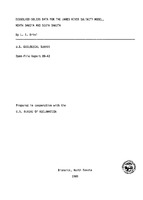Dissolved-solids data for the James River salinity model, North Dakota and South Dakota
Links
- Document: Report (pdf)
- Plate: Plate 1 (pdf)
- Download citation as: RIS | Dublin Core
Abstract
Operation of the Garrison Diversion Unit in North Dakota will divert water from the Missouri River into the James River basin and thereby augment flows in the James River sufficiently to permit expanded irrigation and to provide new water supplies for municipal and industrial use. Salinity of water in the James River currently is marginal for irrigation use f and expanded irrigation may increase river-water salinity beyond acceptable limits. Monthly mean dissolved solids are required by the U.S. Bureau of Reclamation salinity model to predict the effects of different management practices on salinity in the James River. The purpose of this report is to provide a summary of available dissolved-solids data and to discuss methodology to calculate monthly mean dissolved solids. Equations were developed by relating dissolved solids to specific conductance and also by relating specific conductance to streamflow for 15 gaging stations in the James River basin. Dissolved-solids data for supplemental surface-water and ground-water sources to the James River also are summarized.
| Publication type | Report |
|---|---|
| Publication Subtype | USGS Numbered Series |
| Title | Dissolved-solids data for the James River salinity model, North Dakota and South Dakota |
| Series title | Open-File Report |
| Series number | 89-43 |
| DOI | 10.3133/ofr8943 |
| Year Published | 1989 |
| Language | English |
| Publisher | U.S. Geological Survey |
| Contributing office(s) | North Dakota Water Science Center, Dakota Water Science Center |
| Description | Report: v, 239 p.; Plate: 11.57 x 19.25 inches |
| Country | United States |
| State | North Dakota, South Dakota |


